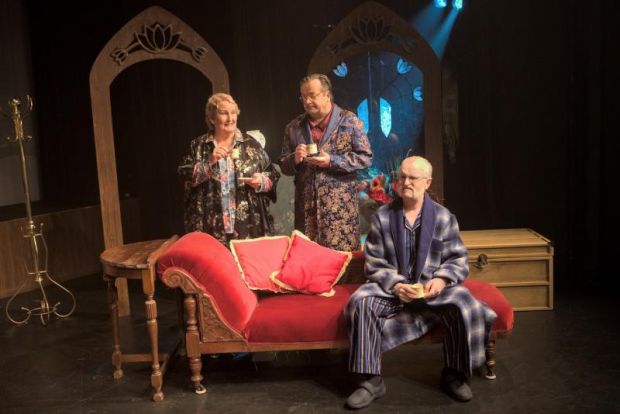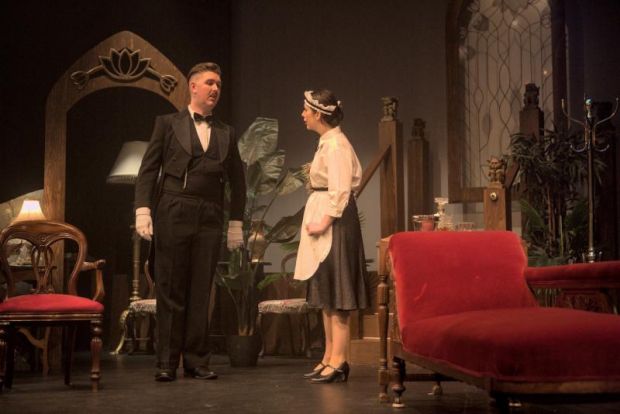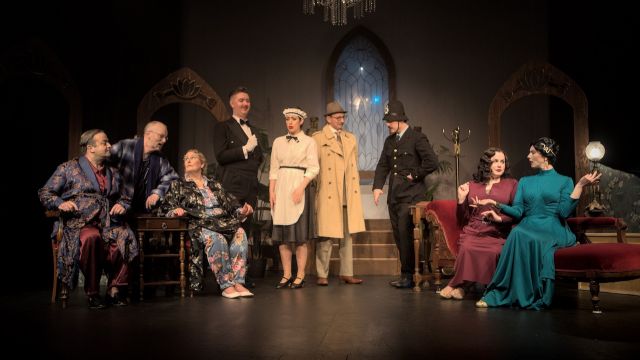Let’s Kill Agatha Christie
Let’s Kill Agatha Christie was written by prolific Hammer Horror screen writer Anthony Hinds. Hinds wrote for most of the second half of the 20th century, publishing this script in 1990 specifically for amateur actors. It is a melodramatic romp which parodies Agatha Christie and exploits every trope of the genre.
There is a cast of nine. Tombs, the butler, may or may not be all he seems. Played by Kyle Enniss with a cockney accent, Tombs is intrinsic to the action, ubiquitous, somewhat sinister but essential to the comedy.
Laura White as aspiring best selling author Prudence Sykes is a fashion plate in every scene. Trained in dance, White moves with exquisite grace and must have been a delight for Robin Rheinberger and Liz Lewinsky to dress.

Angela, the secretary, is played by Tay Lowry, also beautifully costumed with vintage finger waves in her hair. Lowry exercises some restraint in her performance making her the most believable of the characters.
Camilla Best as the housemaid, Gladys, is given some fine histrionic moments in the script as well as a jaunty little cap.
Jonty Hilton is underutilised as the stock character of the Police Constable but also has some fine moments. Brendon Flynn, however, is the archetypal Inspector, a solid and reassuring presence.

Of the household guests, Pip Tyrell is both endearing and ridiculous as Marjory Field. Leigh Faulkner, fading film star John Harvey Miles, revels in the scene in which he is disguised as another character. His self-aware enjoyment of the situation makes it more amusing for the audience. Self-made millionaire Sir Frederick is taken by David Bloomfield. His lapses of pronunciation are perhaps indicative of the fact that he is not all he seems.
The cast is very even although exhibiting a variety of accents. Pace on opening night was very good even though business with props, including innumerable beverages, slowed the action. This was a compromise in bringing to life Whamond’s delightful set.
Augmented by a delightful soundscape of period music, the two-level set consists of four carved arches, an ornate staircase, and a leadlight arched window. The furniture and props are well chosen and evocatively lit by Hayden Green. Prudence Sykes’ predilection for a gloomy ambience gives Green the scope to play with colour and shadow. The fact that the plot specifies the use of an electric generator, enables other effects. The lighting was well considered but the actors were not always able to find their light on the lip of the stage.

Let’s Kill Agatha Christie has a plot full of twists and turns in which the best laid plans go awry – all with comic effect. If it lacks the engagement which comes from a compulsion to ‘nut out’ the identity of the killer which comes with a true Agatha Christie mystery, Let’s Kill Agatha Christie comes with plenty of laughs at the expense of the murder mystery genre.
Anne Blythe-Cooper
Photo credit: Wayne Wagg
Subscribe to our E-Newsletter, buy our latest print edition or find a Performing Arts book at Book Nook.

